The Economist has a wonderful graphic of the countries in the Arab World. Click on the countries for information about the country, including things related to civil rights.
(found via the Daily Dish)
Middle and High School … from a Montessori Point of View
The Economist has a wonderful graphic of the countries in the Arab World. Click on the countries for information about the country, including things related to civil rights.
(found via the Daily Dish)
A successful democratic revolution may well need a relatively wealthy and educated population, however, one of the main things that seem to drive revolutions themselves is just how many young adults there are in a country.
… countries in which 60 percent or more of the population is under the age of 30 are more likely to experience outbreaks of civil conflict than those where age structures are more balanced.
— Madsen (2011): The Demographics of Revolt
When there are lots of young people getting to the age when they are just trying to find jobs and start families, but the country’s economy can’t grow fast enough to provide all the jobs they need, then you have a lot of dissatisfied, disaffected people with time on their hands; it’s a tinderbox ready for any spark.
I recently attended a talk by Jennifer Scuibba where she laid out the case. Scuibba’s blog, also has a
a very good set of links that look at the age demographics of the current revolutions in the Arab world.
One of the links goes to a report by Richard Cincotta and others (Cincotta et al., 2003) that used this type of demographic analysis to figure out which countries were most likely to end up in conflict.
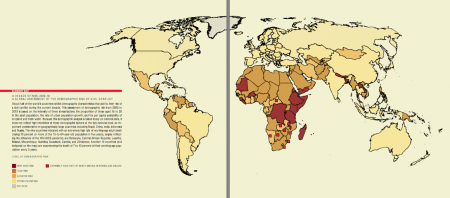
They talk about the demographic transition, “a population’s shift from high to low rates of birth and death,” as being a key factor in reducing the likelihood of conflicts. Therefore, they suggest:
… a range of policies promoting small, healthy and better educated families and long lives among populations in developing countries seems likely to encourage greater political stability
— Cincotta et al., 2003: The Security Demographic – Population and Civil Conflict After the Cold War
If civil conflict leads to a successful democratic transition, then political stability is probably not a net benefit.
However, once there is a democratic revolution, the same large cohort of young people still exists, which could make a country like Egypt unstable for quite a while, until it goes through the demographic transition. After all:
…countries do not become mature democracies overnight. They usually go through a rocky transition, where mass politics mixes with authoritarian elete politics in a volatile way. Statistical evidence covering the past two centuries shows that in this transitional phase of democratization, countries become more aggressive and war-prone, not less …
— Mansfield and Snyder (1995): Democratization and War
NPR reports on the discovery of a 11,500 year old house in Alaska that probably belonged to some of the first people to migrate to the Americas over the Bearing Land Bridge during the last Ice Age. Just 500 years later the Land Bridge was submerged by rising sea levels.
It’s a good article to go to for our discussion of human migration patterns. It also has the added poignancy of the fact that, at the end, the home was turned into a burial crypt for a young member of the family.
I get this question occasionally from my students, and the answer is, of course, that it depends on how you define the word “sound”. Jim Baggott, on the Oxford University Press blog, goes into more detail about the roots of this philosophical conundrum, and makes the parallel to quantum physics.

Physics and philosophy are a dangerous pairing, particularly since if you know enough about one to speak intelligently about it, your probably way out of your depth in talking about the other. Just because you’re an expert in one field does not mean you’re going to be an expert in another. This is especially true of physics and philosophy, which approach the world from such different perspectives and use such different languages: to a physicist, “sound” refers to the vibrations in the air, while a philosopher might argue that “sound” only exists in our minds.
Philosophers have long argued that sound, colour, taste, smell and touch are all secondary qualities which exist only in our minds. We have no basis for our common-sense assumption that these secondary qualities reflect or represent reality as it really is. So, if we interpret the word ‘sound’ to mean a human experience rather than a physical phenomenon, then when there is nobody around there is a sense in which the falling tree makes no sound at all.
— Jim Baggott: Quantum Theory: If a tree falls in forest…
Arasmus is mapping all the events that are happening in Libya. A lot of it’s confusing, things are changing very fast, and who knows where it will end up.
View Mapping Violence Against Pro-Democracy Protests in Libya in a larger map
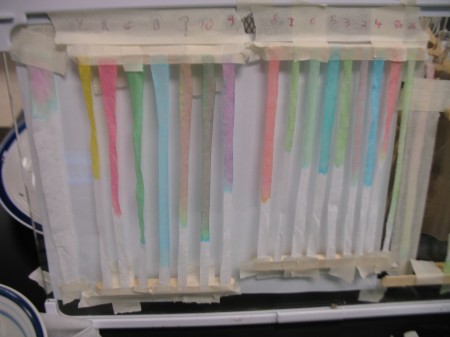

One of the more basic techniques in the microbiologist’s toolkit is gel electrophoresis. It’s used to separate long molecules, like proteins, RNA and DNA from one another. Different organisms have different DNA sequences, so electrophoresis can be used to identify organisms and for DNA fingerprinting. Chromatography is also used to separate different molecules, usually pigments. Therefore, using some filter paper, food coloring, and popsicle sticks I created a nice little chromatographic fingerprinting lab exercise using chromatography as an analogue for electrophoresis.

Using a standard set of four food colors (red, blue, green and yellow), I grabbed each students individually and had them add three drops of the colors of their choice to a test tube with 1 ml of water in it. One students went with three straight blue drops, but most picked some mixture of colors. I kept track of the color combinations they used, and labeled their test tube with a unique, random number.
When they’d all created their own “color fingerprint” in the test tubes, I handed them back out randomly, and gave them the key of names and color combinations (but no numbers). They had to find out whose test tube they had.

I was kind enough to give them a few little demonstrations of chromatography I’d been experimenting with over the last day or so. The easiest technique is simply to place a couple drops of the sample on a filter paper (we used coffee filters “requisitioned” from the teachers lounge), and chase it with a couple drops of water to help the dye spread out. This method works, but since the sample spreads out in a circle, the inverse square law means that the separation of colors can be hard to see.
While the drop method worked well for most students, one who was a bit more analytically-minded, interested in the project, and had a particularly difficult sample, tried doing it using a filter paper column. Since I wanted to show them the proper way of conducting experiments, particularly about the importance of using standards, and I wanted to check if they were able to interpret their results correctly, I also did the full set of samples myself as columns. The standards are essential, because the green food color is actually a mixture of green and blue dyes.
Our color chromatography setup is as you see at the top of this post. We used popsicle sticks to keep the filter paper strips away from the glass surface.
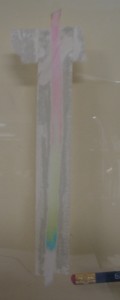
The experiments worked well, and for best results, let the it dry because the colors show up better. One focus with my students was on note-taking and recording results; after a few iterations that worked out well too. Another nice aspect of using the series of columns is that it looks a lot like the electrophoresis bands.
I did try some other variants of the chromatography: top down, bottom up and even taped down. The last version, where I taped the filter paper to the glass to create a restricted column, worked very well.
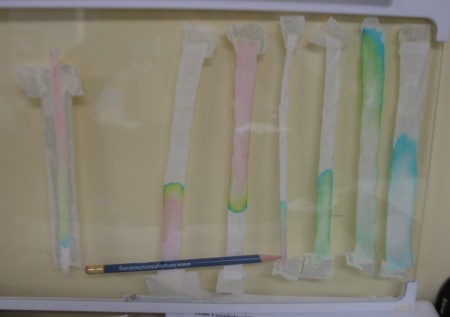
Fortunately, we also know from extensive research both in the U.S. and elsewhere that when we treat teens like adults, they almost immediately rise to the challenge.
— Epstein (2007): The Myth of the Teen Brain in Scientific American Mind.
Is the angst and turmoil we usually associate with adolescence just a result of the way human brains develop, or is it something learned, and depends on the society that shapes our kids? Robert Epstein argues (Epstein, 2007) it’s the latter not the former, and, despite a lot of other research to the contrary, he may have a point. He believes the main problem is that western teens are treated more as children than young-adults, and they spend most of their time socializing with other teens and not with adults.
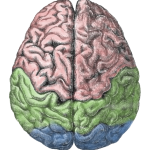
Alex Chediak posts a good overview of the work.
We’ve seen that one of the major problems with most psychological studies is that they only focus on WEIRD people, typically represented by college students in the Western world, who are the easiest people for university researchers to study. Using any such subset must, necessarily, be unrepresentative of the full range of human behavior. Furthermore, since society influences brain development, even studies that focus less on behavior and more on neurological imaging are likely to be affected by the some bias.
A similar argument can be made for studies of adolescence since most studies of adolescence focus on western teens. As a result, separating behavior learned via social interaction, from the regularly progression of genetically programmed brain development is going to be difficult.
Much of Epstein’s argument is based on the book Adolescence: An Anthropological Inquiry (Schlegel and Barry, 1991), which compared teens in almost 200 pre-industrial societies. Epstein summarizes this and other work to indicate that in pre-industrial cultures:
- about 60 percent had no word for “adolescence,”
- teens spent almost all their time with adults,
- teens showed almost no signs of psychopathology
- antisocial behavior in young males was completely absent in more than half these cultures and extremely mild in cultures in which it did occur.
- teen trouble begins to appear in other cultures soon after the intro- duction of certain Western influences, especially Western-style schooling, television programs and movies.
— Epstein (2007) (my bulleting): The Myth of the Teen Brain in Scientific American Mind.
As a result, teens:
learn virtually everything they know from one another rather than from the people they are about to become. Isolated from adults and wrongly treated like children, it is no wonder that some teens behave, by adult standards, recklessly or irresponsibly.
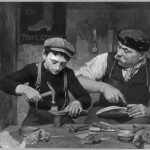
Epstein’s antidote is to treat teens like adults. I agree. However, it’s essential to keep in mind what type of adults we want them to be: responsible and logical, while retaining the creativity we usually associate with childhood. This is something that typifies the ideal of Montessori education, all the way from early-childhood up.
NYU scientists have traced the evolution of tomcod fish that’s been driven by pollution in the Hudson River. The NPR article is nice because it really breaks down how fish with the right genes preferentially survived the PCBs and dioxins in the river, and passed their genes on.
It also turns out that the fish “selected” for pollution tolerance end up being more sensitive to other things, like high water temperatures. It really puts, “survival of the fittest” in context. The fish are “fit” for polluted rivers, but not “fit” for warmer water.